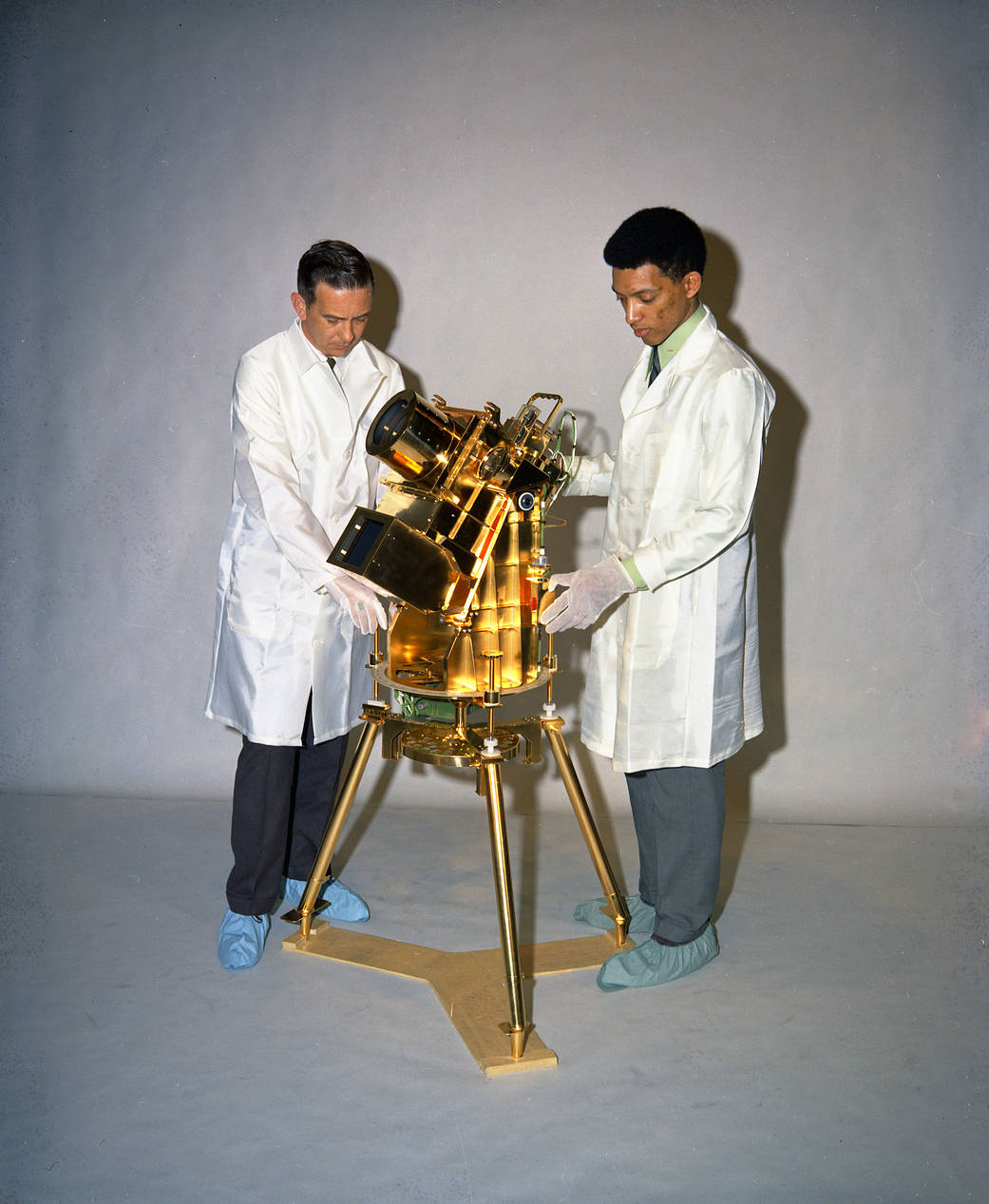Dr. George Carruthers, a scientist at the Naval Research Laboratory, stands to the right of his invention, the gold-plated ultraviolet camera/spectrograph. The first Moon-based observatory, Carruthers developed it for the Apollo 16 mission. He stands beside his colleague William Conway. Working for the Naval Research Laboratory, Carruthers had three years earlier received a patent for a Far Ultraviolet Electrographic Camera, which obtained images of electromagnetic radiation in short wavelengths.
Apollo 16 astronauts placed the observatory on the Moon in April 1972, where it sits today on the Moon’s Descartes highland region, in the shadow of the lunar module Orion. Asked to explain highlights of the instrument’s findings for a general audience, Dr. Carruthers said “the most immediately obvious and spectacular results were really for the Earth observations, because this was the first time that the Earth had been photographed from a distance in ultraviolet (UV) light, so that you could see the full extent of the hydrogen atmosphere, the polar auroris and what we call the tropical airglow belt.”
Dr. Carruthers made the first detection of molecular hydrogen in space, in 1970, using a sounding rocket. He developed a rocket instrument that obtained a UV image of Comet Halley, and an instrument with two cameras, with different far-UV wavelength sensitivities, used on the STS-39 space shuttle mission in 1991. He also worked on UV imaging of Earth’s polar auroras and of the faint photochemical luminescence found in the upper atmosphere, with an instrument, Global Imaging Monitor of the Ionosphere (GIMI), on a Department of Defense satellite, the Advanced Research and Global Observation Satellite (ARGOS), launched in 1999. In 2012, he was awarded the National Medal of Technology and Innovation, the nation’s highest honor for technology achievement. Dr. Carruthers extended his work beyond his scientific endeavors; in the 1980s, he helped launch a program called the Science and Engineers Apprentice Program, which gives high school students the opportunity to do research at the Naval Research Laboratory. He also taught science classes at Howard University in Washington, D.C.
Dr. Carruthers passed away on Dec. 26, 2020, and is remembered for his contributions to physics, astronomy, and education.
Image Credit: U.S. Naval Research Laboratory
海军研究实验室的科学家乔治·卡拉瑟斯博士站在他的发明——镀金紫外线照相机/摄谱仪的右边。卡拉瑟斯为阿波罗16号任务开发了第一个月球天文台。他站在他的同事威廉·康威旁边。在美国海军研究实验室工作的卡拉瑟斯在三年前就获得了远紫外线电成像相机的专利,这种相机可以获得短波长的电磁辐射图像。
1972年4月,阿波罗16号的宇航员将这个天文台放在了月球上,现在它就坐落在月球的笛卡儿高原地区,在猎户座登月舱的阴影处。当被问及向普通大众解释该仪器发现的亮点时,卡拉瑟斯博士说:“最直接、最明显和最壮观的结果确实是对地球的观测,因为这是第一次从远处用紫外线(UV)对地球进行拍照,这样你就可以看到氢大气、极地极光和我们所说的热带气辉带的全部内容。”
卡拉瑟斯博士于1970年使用探空火箭首次探测了太空中的氢分子。他开发了一种火箭仪器,可以获得哈雷彗星的紫外线图像,以及一种带有两个具有不同远紫外线波长灵敏度的相机的仪器,于1991年用于STS-39航天飞机飞行任务。他还在1999年发射的美国国防部高级研究和全球观测卫星(ARGOS)上安装了电离层全球成像监测仪(GIMI),研究地球极地极光的紫外成像和在高层大气中发现的微弱光化学发光。2012年,他被授予国家科技创新奖章,这是国家科技成就的最高荣誉。卡拉瑟斯博士将他的工作拓展到了科学工作之外;在20世纪80年代,他帮助启动了一个名为“科学与工程师学徒计划”(Science and Engineers Apprentice program)的项目,为高中生提供在海军研究实验室(Naval research Laboratory)做研究的机会。他还在华盛顿特区的霍华德大学教授科学课程。
卡拉瑟斯博士于2020年12月26日去世,他因对物理学、天文学和教育的贡献而被人们铭记。
图片来源:美国海军研究实验室







